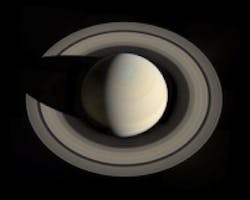NASA releases striking new infrared and downward-looking images of Saturn
Imaging systems aboard the Cassini spacecraft have captured a number of new images of Saturn and its rings, including an infrared scan, an infrared scan with high contrast, and a downward-looking view of Saturn like it has never been seen before.
Cassini is equipped with a number of optical remote sensing instruments which allows the spacecraft to study Saturn and its rings and moons in the electromagnetic spectrum. One of these instruments, Cassini’s Imaging Science Subsystem, was used to capture the downward-looking view image (above). This system includes a CCD image sensor comprised of a 1,024 square array of pixels, each 12 µm on a side, a focal length of 200mm, and a field of view of 3.5°. The camera’s data system allows for on-chip summing and data compression and its two filter wheels, each of which has nine filters, allows for the camera to capture images at specific wavelengths of light.
The images were obtained by Cassini, but were composed into the one main image by amateur image processor and Cassini fan Gordan Ugarkovic, according to NASA. The image—which has not been geometrically corrected for shifts in the spacecraft—was created from 12 image footprints with red, blue, and green filters from Cassini’s imaging science subsystem. Ugarkovic used full color sets for 11 of the footprints and red and blue images for one footprint.
The two infrared scans captured by Cassini were captured by Cassini’s visible and infrared mapping spectrometer (VIMS). The VIMS system is a pair of imaging grating spectrometers designed to measure reflected and emitted radiation from atmospheres, rings, and surfaces over wavelengths from 0.35 to 5.1 µm:
- Visible channel (0.35 to 1.07 µm [96 channels]; 32x32 mrad field of view)
- Infrared channel (0.85 to 5.1 µm [256 channels]; 32x32 mrad field of view)
The image (and the high-contrast image) covers a band of Saturn and its rings about 340,000 miles across which includes the planet and its rings out to the diffuse E rings, Saturn’s second most distant ring.
The Cassini-Huygens mission is a cooperative project of NASA, the European Space Agency and the Italian Space Agency. NASA’s Jet Propulsion Laboratory (JPL) manages the mission for NASA's Science Mission Directorate. The California Institute of Technology manages JPL for NASA. The VIMS team is based at the University of Arizona in Tucson.
View more information on the Cassini mission.
Also check out:
European telescope captures striking image of Prawn Nebula stellar nursery
NASA releases image of Saturn's view of Earth
Astronomers capture sharpest ever images of night sky
Share your vision-related news by contacting James Carroll, Senior Web Editor, Vision Systems Design
To receive news like this in your inbox, click here.
Join our LinkedIn group | Like us on Facebook | Follow us on Twitter | Check us out on Google +
About the Author

James Carroll
Former VSD Editor James Carroll joined the team 2013. Carroll covered machine vision and imaging from numerous angles, including application stories, industry news, market updates, and new products. In addition to writing and editing articles, Carroll managed the Innovators Awards program and webcasts.
